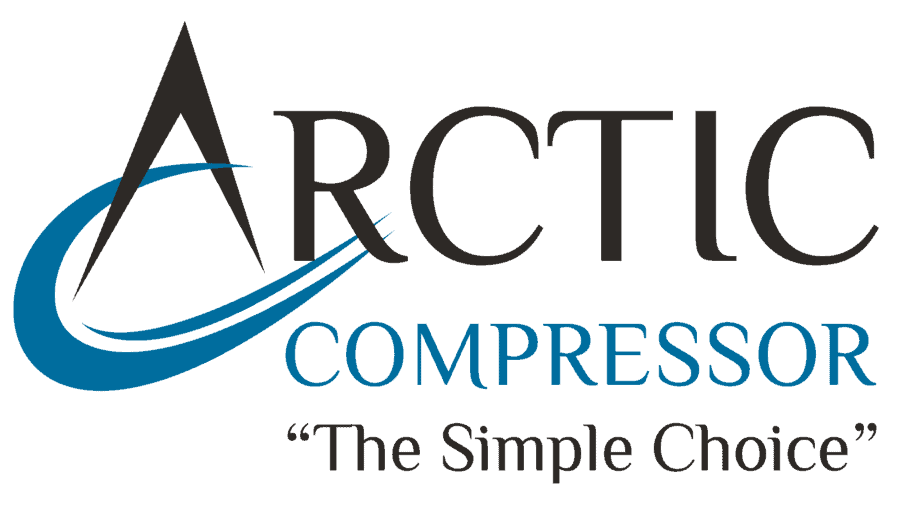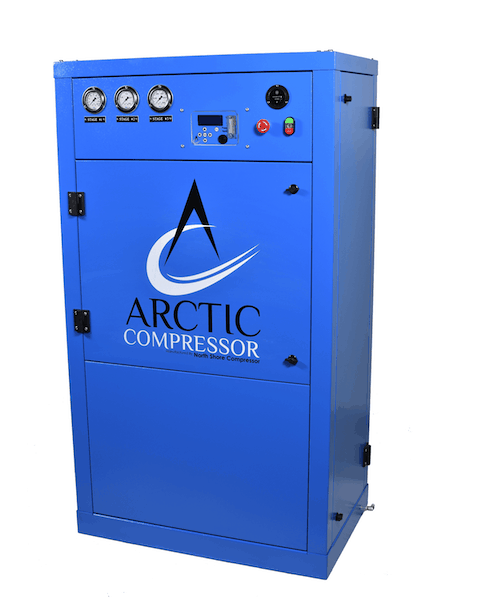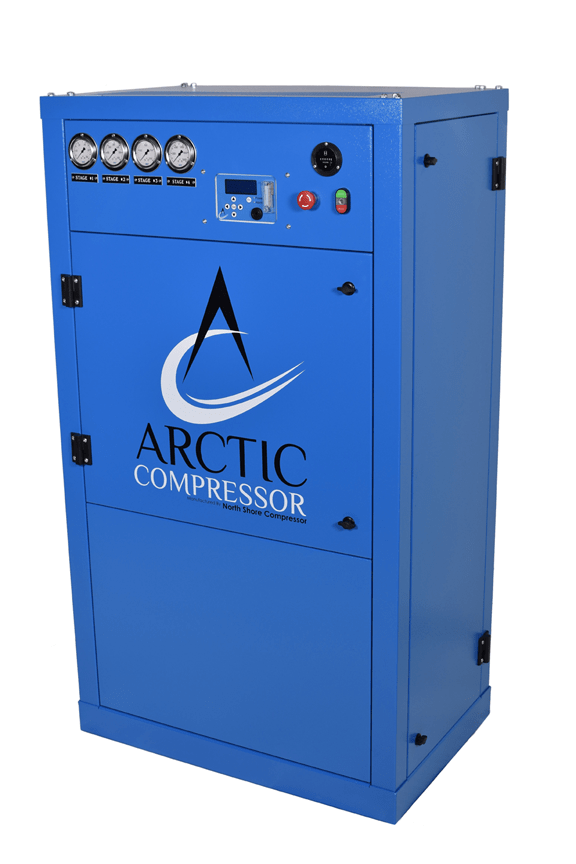The main function of a compressor system is to increase the pressure by reducing the volume of a given gas, such as air or nitrogen. There are several compressor designs that provide different performance benefits.
Here’s what we’ll cover:
Click on any of the topics to jump to that section.
- Multi-stage compressors
- 3 Stage Air Compressors
- 4 Stage Air Compressor
- 3 Stage vs 4 Stage Compressors
- What to Consider When Choosing an Air Compressor
- Additional Accessories
Multi-stage compressors
The essential function of a multi-stage compressor is to increase the overall pressure from input to output one stage at a time, by forcing ambient air into successively smaller spaces with each stage. Multiple stages of compression are more efficient in their ability to compress the air to the final output than the performance capability of only a single stage.
The by-product of compression is heat. If too much compression is employed in a single stage, the absolute safe temperature limits of the equipment may be exceeded and cause mechanical strain. These effects limit the practical compression of each stage. As the pressure of the air increases, its temperature rises. It is therefore essential to reduce the air temperature to avoid damage to the mechanical elements. Multi-stage compressors use inter-stage cooling to dissipate additional heat during the compression process.
Multi-stage compression is achieved by employing a series of decreasing diameter cylinder stages, and intercoolers that cool the air between each of these compression stages.
The compressed air from the first stage enters the intercooler where it is cooled. This air is given as input to the second stage where it is compressed again. The third and fourth stages repeat the process. Once the desired output pressure is achieved, the compressed air is cooled once again in an after-cooler to reduce the final output temperature before filtration and end use.
As the required output pressure of the compressor system is increased, the number of stages required will also increase. By cooling the air between compression stages, the energy required for compression is reduced. Therefore, all else being equal if you increase the number of compression stages to achieve your desired output pressure, you will increase the overall efficiency of your compressor.
3 Stage Air Compressors
Arctic 1000 series compressors are designed to operate up to 6000 PSI. To achieve this high of an operating pressure 3 stages of compression are required. Three stage high pressure air compressors are well suited and commonly used for many applications including:
- Fire department (for SCBA cylinders)
- Industrial pressure testing
- SCUBA diving
- Paintball
- PCP Air Rifles
Most small and medium air volume applications can easily be met with a 3 stage compressor.
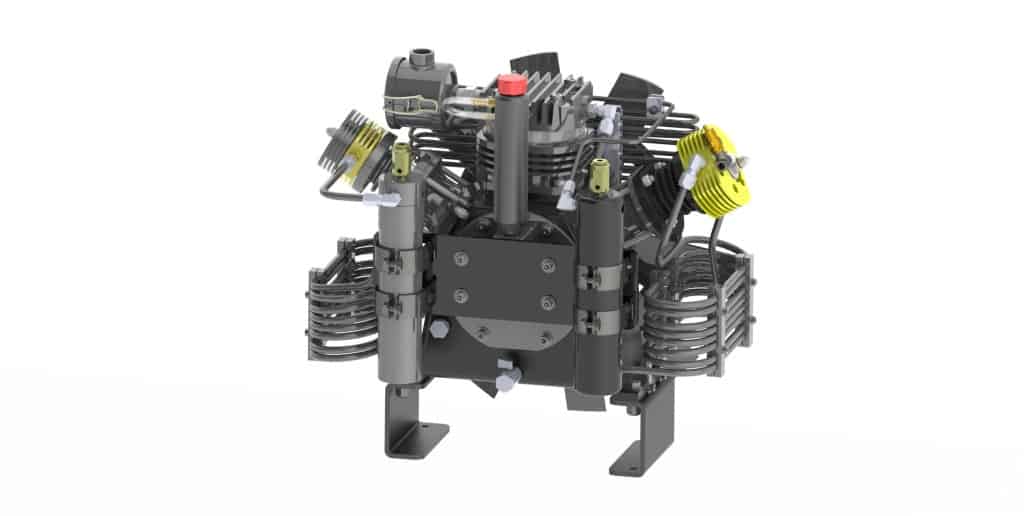
4 Stage Air Compressors
Similarly, a 4 stage compressor uses its additional compression step to perform more efficiently than a comparative 3 stage system. A higher volume output can be achieved with an equal energy input. For applications that require a longer continuous run time and need a larger volume of high pressure air, this 4 stage difference can be key to selecting the right solution.
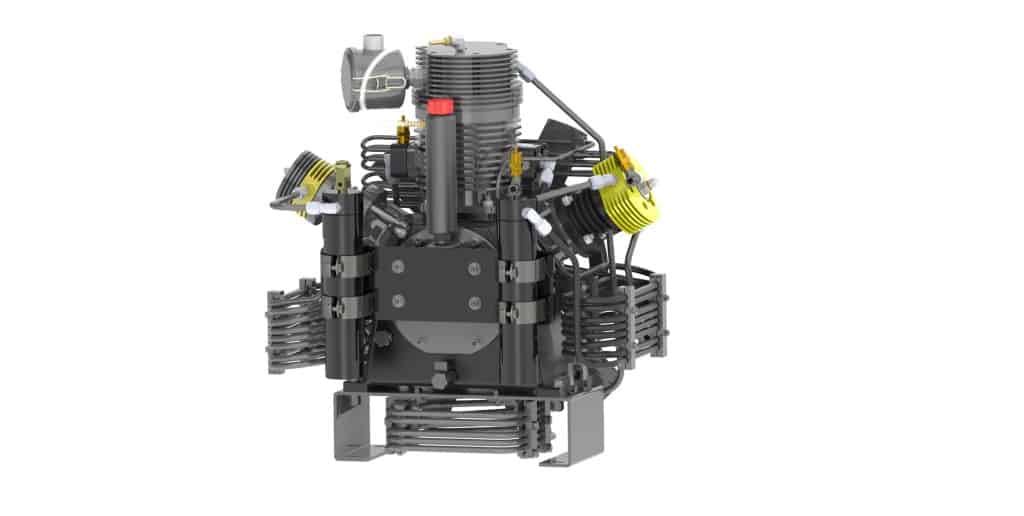
3 stage vs 4 stage air compressors
The trade-off between 3 and 4 stage compressors is one of mechanical complexity vs energy efficiency. A 3 stage compressor is less mechanically complex than a 4 stage compressor. However, given the same energy input the 3 stage compressor will output less compressed air than the equivalent sized 4 stage compressor. With the additional efficiencies, 4 stage systems also operate comparatively cooler.
The overall fewer stages, as well as parts and complexity, the cost to purchase, service, and maintain a 3 stage system over its life is generally less.
Arctic 1000 Series Enclosed Compressor
- 3 Stage Arctic Compressor Block
- Air Cooled with High Velocity 10 Bladed Fan
- Relief Valves on All Stages
- Aluminum Inter-Coolers
- Interstage and Final Moisture Separators
While machines with 4 stages of compression are more energy efficient and can provide higher air flow rates, they are also more mechanically complex and generally higher in price. However, this does help lower the general operating expenses due to efficiency. The extra compression stage adds many additional components to the compressor. This creates more complexity that adds additional cost and servicing over the life of the system. Applications that demand a larger volume of compressed air can justify the additional costs for a 4 stage compressor. In lower volume applications, the added capital and operating costs of a 4 stage system may not be practical.
Arctic 1500 Series Enclosed Compressor
- 4 Stage Arctic Compressor Block
- Air Cooled with High Velocity 10 Bladed Fan
- Relief Valves on All Stages
- Aluminum Inter-Coolers
- Interstage and Final Moisture Separators
What to consider when choosing an air compressor
1. Air pressure requirements (PSI)
The final use pressure of the compressed air is one of the most important factors to consider when selecting a compressor. Final pressures can very widely depending on application. Below are a few common applications and pressures.
- Fire / Hazmat SCBA (2216 PSI, 4500 PSI and 5500 PSI)
- SCUBA diving (3000 PSI, 3500 PSI)
- Valve Testing (500 – 6000 PSI)
- Paintball / PCP rifles (3000 PSI, 4500 PSI)
- Air tools (approx 100 PSI)
It is best to choose a compressor that is capable of producing a higher pressure than your end use application requires. It is very common to store a volume of air at a higher pressure than you require and use a pressure reducing regulator the supply your end use. This provides several benefits, like reducing the on / off cycling of the compressor, and providing stored capacity for times of high demand.
2. Air flow capacity requirements (SCFM)
Once you have determined your pressure requirement, the next important factor is your volume requirement. Air flow capacity requirements are typically stated as cubic feet per minute (CFM). Another term that is often used in the industry is the Standard CFM (SCFM). It is defined as the measured flow of free air with a common set of reference conditions (14.5 PSI, 68 Degrees F, and 0% relative humidity). This is all a long way of saying that volumes are calculated at normal atmospheric pressure and normal room temperature.
3. Power Requirements
The next important consideration is how you are going to power your compressor. Are you planning to power your compressor electrically or with an engine?
If you are planning for an electric motor, you need to determine what power you have available. Do you have single phase power, or three phase power available? What voltage do you have available 208V, 230V, 480V?
If you want an engine driven compressor, would you prefer gasoline or diesel? Do you want an electric start, or a recoil start?
4. Duty Cycle
The duty cycle is the percentage of time that the system is operated. How many hours per day, month or year you plan to run the compressor.
All Arctic compressors are rated for continuous use. However, the duty cycle can have an effect on maintenance intervals. If you expect to be using your compressor at a high duty cycle, be sure to ask us about options that can extend your time between maintenance intervals.
Summary
In order to understand your compressor needs, it is important to identify the key areas of your application that will drive compressor performance differences. Buying a compressor that does not keep up with your compressed air demands can waste both your time and money. Buying a compressor that is too large will waste valuable resources as it will require more expenditures than needed.
Here are three questions to ask yourself when choosing a compressor:
- What is the maximum required operating pressure (PSI)?
- What is the maximum required volume (SCFM)?
- What power do you have available to run the compressor?
- How many hours per month do you plan to run the compressor?
Additional features and accessories
Some key optional features may need to be considered for your compressor system.
A Real Time Electronic carbon monoxide (CO) monitor identifies potentially dangerous situations for your staff where CO levels could reach unsafe conditions.
Additional internal filtration capacity can reduce your required maintenance intervals.
A low oil level shutdown protects your investment from damage due to insufficient lubricant levels for the system to operate effectively. The system will automatically shut down ahead of a situation that could cause any damage.
Why choose Arctic Compressor for your compressor needs
Arctic Compressor offers 3 and 4 stage high-pressure compressors to fit your application’s needs. The 3 stage family, A1000, is offered in either an enclosed or open frame model. The more powerful 4 stage A1500 models provide up to 14 CFM using 10 HP. Compressor accessories and companion equipment from containment fill stations, high pressure storage cylinders, hose reels, and compressor blocks as are also available on our website. Contact us to request a quote today.
